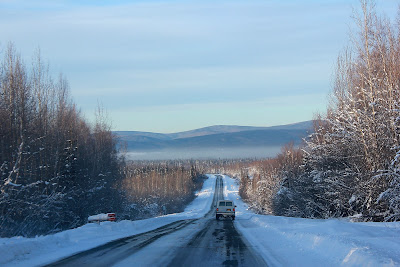On Friday, at 3pm, I meet
up with Andrew. After several days of email exchanges, I met him for
the first time the day before. He offered me to come with him and his
friends for a week-end. We buy some stuff. We pass by his house to
pick up warm gear: from glove liner to down jacket, not to forget
-10°C down sleeping bags. We take material to cook and eat, to melt
snow, skis, games, swimsuits (you'll see...).
At night, we arrive at the
cabin. It is a 6x6 meter room with a wood stove, a massive table in
the middle and six wooden bunk beds. No electricity: we warm the
cabin with the wood stove and we cook on it. No running water: we
melt snow and toilets are outside. 11 people and 5 dogs are going to
spend the whole week-end in this space. Nice atmosphere. I try to
concentrate on conversations since the US slang is slightly different
from the UK slang I am used to and because it is not really my time
(still a bit jet-lagged). Dogs are also very happy!
On Saturday, cross-country
skiing is on the programme. We plan 14 miles (approx. 20 km). Getting
dressed takes ages! Every detail is important. Then we can go. The
sun is there, as it is everyday for about 6 hours a day. It doesn't
go very high on the horizon, but it gives incredible colours during
the (never-ending at this latitude) twilight.
Tacit rule: each of us
goes at his/her own rhythm. We can't stop too much, neither too
often, otherwise we freeze and it becomes hard to get warmer. At the
middle of the distance, we make a stop in another cabin where we can
light a fire and eat what America can best offer as junk-food. We
could almost see the level rising in our internal calorie-meter.
Awesome! We can eat whatever we want, we know we are going to burn
all this before getting back to the cabin tonight.
We set off again.
Landscape is hilly, with snow and a lot of fine pines. Outdoor
temperature is about -40°. No need to ask whether it is expressed in
Celsius or Fahrenheit: at this very temperature, Celsius is
equivalent to Fahrenheit. Being warmly dressed and moving
continuously are the keys to avoid turning into ice. On the contrary,
the body is so hot compared to outside that it produces condensation
that freezes on external surfaces (e.g. clothes, eyebrows, eyelashes,
etc.). At the end of the day, my fingers hurt, most likely because of
the constant temperature changes.
Dogs hold out pretty well
wearing little coats and kind of socks. My computer stayed home. But
my camera surprisingly hang out also quite well, whereas it is not
recommended to bring it out in negative temperatures (from 30°F).
Eventually, it made good pictures. At the end of the day, I have to
admit that cross-country skiing is way better than what I experience
15 years ago. I am not totally convinced that I was faster than a
hiker, but I arrived before it was pitch dark!
We cut some logs for
cooking and warming up the cabin. To do so, we went along the frozen
river. My left leg will remember that the edge of the river are less
frozen... Fortunately I had a spare pair of socks. For diner: chili
con carne and peanut butter balls (that was killer!).
In the evening, we took
the cars to head for the Chena hot springs. What a surprise when the
tenant confirmed: “55 below”! Personal record from Kosovo broken
by almost 20°C. Back to business; here comes the moment when we need
our swimsuits. You have to run a few seconds half naked to reach the
outdoor pool. The water temperature is about 40°C (about
100°F), which means a thermal
amplitude of 90°C (155°F). Fortunately, the outdoor temperature is
not 10°C, otherwise we would have ended the same way the lobster do
in a pan!
We don't feel cold in this
hot water. We could stay for hours. Andrew notices that even if we
gained like 50°F it would still be 5 below (-20°C). The air is very
wet around the springs and in this temperature, hair freezes quite
fast when it is wet. Wonderful white hairstyle possible!
Unfortunately, with the condensation, the camera didn't work. Anyway,
relaxation after a sportive day is just perfect. We could then head
back to the cabin and wrap ourselves up warmly for the night.
On Sunday, after a brunch
made up of eggs, bacon and ginger-stout cake, it is high time to take
care of the vehicles. In those temperatures, they also suffer.
General warm-up is highly needed before even think of starting the
engine. Gas doesn't freeze but oil becomes thicker than honey.
Vehicles are plugged to a generator. That will warm up the engine and
the battery. Another solution is to burn charcoal under the engine.
An ultimate alternative is to warm it up with a blowtorch. It takes
about two to three hours, but it is quite fascinating for someone
who's interested in cars.
Back to Andrew and Anna's,
we realise that the heater is off. Inside temperature droped below
0°C. The cat is so freaked out. I'm sure he saw himself turning into
Popsicle. Poor Dobby! Anyway, emergency measure: turn the heater on
to avoid the explosion of the pipes.
That was a fun week-end with a bunch of nice people!
Not even here longer than a week and I already experienced a lot of
the Alaskan winter. Tomorrow, I'll write on the my programme for the
coming days, or most probably on the options ahead.









